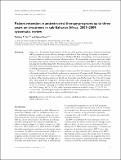| dc.contributor.author | Fox, Matthew P | |
| dc.contributor.author | Rosen, Sydney | |
| dc.date.accessioned | 2021-09-01T21:07:24Z | |
| dc.date.available | 2021-09-01T21:07:24Z | |
| dc.date.issued | 2010-06 | |
| dc.identifier.citation | Fox MP, Rosen S. Patient retention in antiretroviral therapy programs up to three years on treatment in sub-Saharan Africa, 2007-2009: systematic review. Trop Med Int Health. 2010 Jun;15 Suppl 1(s1):1-15. doi: 10.1111/j.1365-3156.2010.02508.x. PMID: 20586956; PMCID: PMC2948795. | en_US |
| dc.identifier.other | PMID: 20586956 | |
| dc.identifier.uri | http://repository.amref.org/handle/123456789/214 | |
| dc.description.abstract | Objectives
To estimate the proportion of all-cause adult patient attrition from antiretroviral therapy (ART) programs in service delivery settings in sub-Saharan Africa through 36 months on treatment.
Methods
We identified cohorts within Ovid Medline, ISI Web of Knowledge, Cochrane Database of Systematic Reviews and four conference abstract archives. We summarized retention rates from studies describing observational cohorts from sub-Saharan Africa reporting on adult HIV 1- infected patients initiating first-line three-drug ART. We estimated all-cause attrition rates for 6, 12, 18, 24, or 36 months after ART initiation including patients who died or were lost to follow-up (as defined by the author), but excluding transferred patients.
Results
We analysed 33 sources describing 39 cohorts and 226 307 patients. Patients were more likely to be female (median 65%) and had a median age at initiation of 37 (range 34–40). Median starting CD4 count was 109 cells/mm3. Loss to follow-up was the most common cause of attrition (59%), followed by death (41%). Median attrition at 12, 24 and 36 months was 22.6% (range 7%–45%), 25% (range 11%–32%) and 29.5% (range 13%–36.1%) respectively. After pooling data in a random-effects meta-analysis, retention declined from 86.1% at 6 months to 80.2% at 12 months, 76.8% at 24 months and 72.3% at 36 months. Adjusting for variable follow-up time in a sensitivity analysis, 24 month retention was 70.0% (range: 66.7%–73.3%), while 36 month retention was 64.6% (range: 57.5%–72.1%).
Conclusions
Our findings document the difficulties in retaining patients in care for lifelong treatment, and the progress being made in raising overall retention rates.
Keywords: antiretroviral therapy, attrition, retention, sub-Saharan Africa, systematic review, human immuno-deficiency virus | en_US |
| dc.description.sponsorship | United States Agency for International Development (USAID) under the terms of agreement 674-A-00-08-00007-00 with Right to Care (RTC), and by the Doris Duke Charitable Foundation through a grant to Boston University. Also National Institute of Allergy And Infectious Diseases. | en_US |
| dc.language.iso | en | en_US |
| dc.publisher | Blackwell Publishing Ltd. | en_US |
| dc.subject | Antiretroviral therapy (ART) | en_US |
| dc.subject | Systematic Reviews | en_US |
| dc.subject | HIV | en_US |
| dc.subject | Patient | en_US |
| dc.title | Patient Retention in Antiretroviral Therapy Programs up to Three Years on Treatment in Sub-Saharan Africa, 2007-2009: Systematic Review: Patient Retention in Antiretroviral Therapy Programs | en_US |
| dc.type | Article, Journal | en_US |

